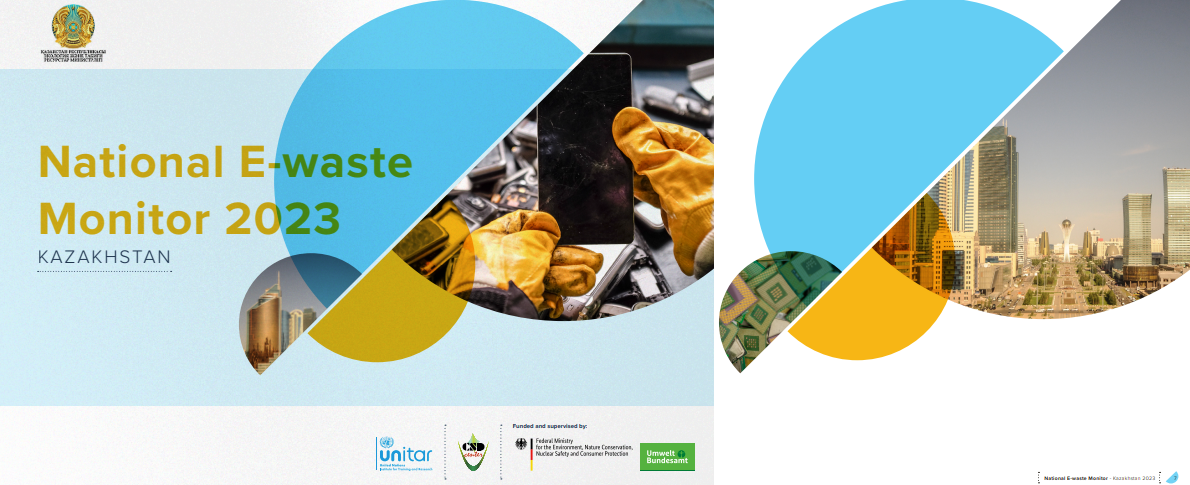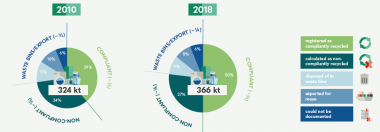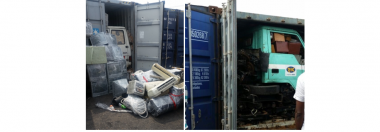By browsing the https://globalewaste.org website and using its online services, you agree to the following:
Unless specified otherwise, the content on this website is available under the Creative Commons Attribution-NonCommercial-ShareAlike 3.0 IGO licence (CC BY-NC-SA 3.0 IGO; https://creativecommons.org/licenses/by-nc-sa/3.0/igo/).
Under the terms of this licence, you may copy, redistribute and adapt the content on this website for non-commercial purposes, provided such content is appropriately cited, as indicated below. In any use of the content, there should be no suggestion that ITU, UNU or UNITAR endorses any specific organization, products or services. The unauthorized use of the ITU, UNU or UNITAR names or logos is not permitted. If you adapt the content, then you must license your work under the same or equivalent Creative Commons licence. If you create a translation of this content, you should add the following disclaimer along with the suggested citation: “This translation was not created by the International Telecommunication Union (ITU), the United Nations University (UNU) or the United Nations Institute for Training and Research (UNITAR). Neither ITU, UNU nor UNITAR are responsible for the content or accuracy of this translation. The original English edition shall be the binding and authentic edition”.
Third-party materials. If you wish to reuse material from this website that is attributed to a third party, such as tables, figures or images, it is your responsibility to determine whether permission is needed for that reuse and to obtain permission from the copyright holder. The risk of claims resulting from infringement of any third-party-owned component in the work rests solely with the user.
General disclaimers. The designations employed and the presentation of the material on this website do not imply the expression of any opinion whatsoever on the part of ITU, UNU or UNITAR concerning the legal status of any country, territory, city or area or of its authorities, or concerning the delimitation of its frontiers or boundaries. Dotted and dashed lines on maps represent approximate border lines for which there may not yet be full agreement.
The ideas and opinions expressed in the content on the website are those of the authors; they do not necessarily reflect those of ITU, UNU and UNITAR. The mention of specific companies, products or services does not imply that they are endorsed or recommended by ITU, UNU or UNITAR in preference to others of a similar nature that are not mentioned. Errors and omissions excepted, the names of proprietary products are distinguished by initial capital letters.
All reasonable precautions have been taken by ITU, UNU or UNITAR to verify the information contained in the content on this website. However, the published material is being distributed without warranty of any kind, either expressed or implied. The responsibility for the interpretation and use of the material lies with the user. In no event shall ITU, UNU or UNITAR be liable for damages arising from its use.
As a condition of use of this website, you agree to indemnify ITU, UNU and UNITAR and its affiliates from and against any and all actions, claims, losses, damages, liabilities and expenses (including reasonable attorneys’ fees) arising out of your use of this website, including, without limitation, any claims alleging facts that if true would constitute a breach by you of these Terms of Use. If you are dissatisfied with any content on this website or with any of the Terms of Use, your sole and exclusive remedy is to discontinue using the website.
Nothing in these Terms of Use shall be deemed to be a waiver, express or implied, of the privileges and immunities of the United Nations University, United Nations Institute for Training and Research or the International Telecommunication Union, accorded to them under international law or any applicable national laws.
Privacy notice. Simply browsing this website does not require you to provide any personal information. However, we (the UNU, ITU and UNITAR) do process information that is collected automatically through browser “cookies”, i.e. small pieces of data sent from this website and stored on your device, in order to maintain your website user preferences, make the website work more efficiently, and compile anonymous reports to help us improve the website. To this end, we use Google Analytics to help us improve the website and its online services, whereby only the default information is collected by Google Analytics. You can find Google Analytics Privacy Policy and Terms of Service under: https://policies.google.com/. We further use the Advanced Custom Fields PRO plugin to add custom fields to pages, the Breeze plugin to cache frontend js/css and the FV Simpler SEO to optimize SEO. You can find details to this plugins under: https://www.advancedcustomfields.com, https://wordpress.org/plugins/breeze/, https://wordpress.org/plugins/fv-all-in-one-seo-pack respectively.
The above mentioned cookies typically contain information about your IP address, browser type and/or operating system, collected in an aggregated and anonymous manner and solely for statistical purposes and not to identify you as an individual user. You can delete these cookies anytime, by accessing the appropriate menu of your web browser. You may also opt to deactivate cookies completely through your browser preferences; however, this may affect the functioning or appearance of the website.
We do not share your personal information with third parties, unless we engage them as subcontractors to perform certain business operations on our behalf (as those mentioned below) or unless such sharing is necessary to run the website and/or provide the online services on the website. In this regard, such third parties are allowed to process your information only in accordance with our instructions and for a limited duration. More specifically, this website was developed by Netpulse and hosted in cooperation between Netpulse and TransIp.
ITU, UNU and UNITAR reserve the right to change these Terms of Use and Privacy Notice at any time. Any revisions will be posted to this page. Continued use and browsing of this website after such changes shall constitute your consent to such changes.
How to contact us. If you have any questions about these Terms of Use and Privacy Notice, please do not hesitate to contact The Global E-waste Statistics Partnership at: info@globalewaste.org













